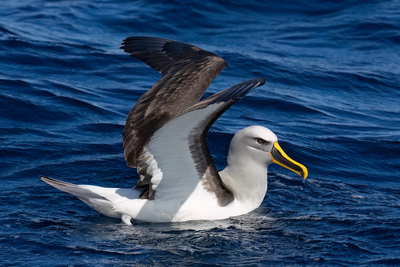Wind energy study to protect wildlife from collisions

Monash University researchers have compiled a practical guide to seabird flight behaviour to help policymakers and the renewable energy industry better ensure seabirds are protected from collision risk with offshore wind farms.
A number of renewable energy companies are working through the environmental assessment process, which includes consideration of the potential impacts of wind farms on iconic seabirds such as the albatross.
Lead author Dr Mark Miller, a research fellow in the Monash School of Biological Sciences, said the research provides evidence-based details on how high, how fast and at what time of day albatrosses, petrels, shearwaters and storm petrels fly.
“This will help scientists and policymakers better understand and mitigate the risks of these unique seabirds colliding with offshore wind turbines,” Miller said. “Australia is developing a comprehensive environmental and cultural impact assessment process for new wind infrastructure, but with no offshore wind farms in the Southern Hemisphere yet, there are still key gaps in knowledge.
“One of these is that we currently have a poor understanding of seabird flight behaviour and how this might influence collision risks for iconic species such as albatrosses and petrels.”
To compile the guide, researchers drew on published data on the flight patterns of 119 seabird species. However, Miller said additional research is needed to determine flight height.
“This is a crucial information gap, and one that should be a priority action for the offshore wind industry,” Miller said. “Seabirds typically fly close to the ocean surface, so raising the height of turbines is one very practical way to mitigate collision risk.
“The work we have done aims to constructively inform policy development at the intersection of biodiversity conservation and renewable energy; two areas inherently linked.”
The vast majority of seabirds are under threat of extinction, reducing globally by up to 70% in the past 50 years. Albatrosses, petrels, shearwaters and storm petrels include both the most threatened and abundant seabird families, making them a clear conservation priority.

The Department of Climate Change, Energy, the Environment and Water is currently working through granting feasibility, or conditional licensing to companies to kick off the development of its six declared offshore wind areas. Licensees will still be required to meet environmental and other requirements, and undertake community consultation.
Associate Professor Rohan Clarke, Head of the Research, Ecology and Conservation Group at the School of Biological Sciences, said ecologists and the wind energy sector need to collaborate to ensure the renewable transition benefits both people and wildlife, including seabirds.
“Our job is to help deliver the best possible outcomes for biodiversity, and addressing climate change through large-scale action is essential to that goal,” he said. “One of the key challenges we face is what’s known as the ‘green-green dilemma’, where initiatives designed to reduce environmental impact, such as renewable energy development, can unintentionally harm other ecological values.
“But we must identify evidence-based solutions to these competing priorities, because climate change remains the single greatest threat to biodiversity.
“The energy transition isn’t optional; it’s essential, and finding solutions that support both climate goals and nature is critical.”
The full research paper was published in the peer-reviewed Journal of Applied Ecology.
$39m boost to NSW's EV fast charging network
Applications are open for Round 4 of the NSW Government's EV fast charging grants program,...
Agreement unites clean energy providers
Wind and water energy come together as Aula Energy signs a long-term power purchase agreement...
Alta project makes existing diesel trains electric
Alta Battery Technology's BET system has demonstrated that practical, scalable rail...










